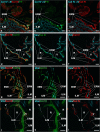The extracellular matrix complexity of idiopathic epiretinal membranes and the bilaminar arrangement of the associated internal limiting membrane in the posterior retina
- PMID: 33760980
- PMCID: PMC8380574
- DOI: 10.1007/s00417-021-05156-6
The extracellular matrix complexity of idiopathic epiretinal membranes and the bilaminar arrangement of the associated internal limiting membrane in the posterior retina
Abstract
Purpose: To study the composition of the internal limiting membrane (ILM) of the retina, the extracellular matrix (ECM) of idiopathic epiretinal membranes (iERMs), and the relationships occurring between the two membranes.
Methods: Forty-six iERMs, 24 of them associated with the ILM, were collected and included in this study. The investigation has been carried out by immunofluorescence and confocal microscopy on glutaraldehyde- and osmium-fixed epon-embedded samples and on frozen samples. Sections were double or triple labelled with antibodies against vimentin; collagens I, III, IV, α5(IV), and VI; laminin 1 + 2; laminin α2-, α4-, α5-, β1-, β2-, β3-, γ1-, and γ2-chains; entactin; and fibronectin.
Results: iERM thickness was not uniform. Almost 14% of iERMs showed thickenings due to folding of their ECM component under the cell layer. The vitreal side of iERMs was often shorter than the attached ILM. In this case, the ILM resulted folded under the iERM. ILMs contained laminin 111; laminin α2-, α5-, β1-, β2-, and γ1-chains; entactin; collagens I; α5(IV); [α1(IV)]2α2(IV); and VI. Laminins, entactin, and α5(IV) were gathered on the retinal half of the ILM, whereas collagens [α1(IV)]2α2(IV) and I were restricted to the vitreal side. Collagen VI was detected on both sides of the ILM. iERMs expressed laminin 111, collagens III, [α1(IV)]2α2(IV) and VI, entactin, and fibronectin. Entactin co-localized with laminins and collagen IV.
Conclusions: Analysis of laminins and collagen chain expression indicates that ILM contains laminin 111 (former laminin 1), laminin 521 (former laminin 11), laminin 211 (former laminin 2), collagen [α1(IV)]2α2(IV), and collagen α3(IV)α4(IV)α5. In contrast, iERMs express only collagen [α1(IV)]2α2(IV) and laminin 111. In addition, both iERMs and ILMs contain entactin. The presence of three major constituents of the basement membranes co-localized together in iERMs is suggestive for a deranged process of basement membrane formation which fails to assemble properly. In view of the many interactions occurring among its proteins, the ECM of either the iERMs or the ILMs can account for their reciprocal adhesiveness. In addition, the peculiar deposition of the ECM observed in some samples of iERM is suggestive for its involvement in the formation of macular puckers.
Keywords: Collagen IV; Epiretinal membrane; Extracellular matrix; Internal limiting membrane; Laminin; Vitreoretinal interface.
© 2021. The Author(s).
Conflict of interest statement
The authors declare that they have no conflict of interest
Figures




Similar articles
-
Untangling the Extracellular Matrix of Idiopathic Epiretinal Membrane: A Path Winding among Structure, Interactomics and Translational Medicine.Cells. 2022 Aug 15;11(16):2531. doi: 10.3390/cells11162531. Cells. 2022. PMID: 36010606 Free PMC article. Review.
-
Distribution of laminins in the developing human eye.Invest Ophthalmol Vis Sci. 2006 Mar;47(3):777-85. doi: 10.1167/iovs.05-0367. Invest Ophthalmol Vis Sci. 2006. PMID: 16505007
-
Cyclo-oxygenase-2 expression in human idiopathic epiretinal membrane.Retina. 2010 May;30(5):719-23. doi: 10.1097/IAE.0b013e3181c59698. Retina. 2010. PMID: 19996819
-
Intraretinal changes in idiopathic versus diabetic epiretinal membranes after macular peeling.PLoS One. 2018 May 8;13(5):e0197065. doi: 10.1371/journal.pone.0197065. eCollection 2018. PLoS One. 2018. PMID: 29738569 Free PMC article.
-
Expression and function of laminins in the embryonic and mature vasculature.Physiol Rev. 2005 Jul;85(3):979-1000. doi: 10.1152/physrev.00014.2004. Physiol Rev. 2005. PMID: 15987800 Review.
Cited by
-
Co-Expression of Podoplanin and CD44 in Proliferative Vitreoretinopathy Epiretinal Membranes.Int J Mol Sci. 2023 Jun 4;24(11):9728. doi: 10.3390/ijms24119728. Int J Mol Sci. 2023. PMID: 37298679 Free PMC article. Review.
-
The mechanics of the retina: Müller glia role on retinal extracellular matrix and modelling.Front Med (Lausanne). 2024 Sep 4;11:1393057. doi: 10.3389/fmed.2024.1393057. eCollection 2024. Front Med (Lausanne). 2024. PMID: 39296899 Free PMC article. Review.
-
Localizations of Laminin Chains Suggest Their Multifaceted Functions in Mouse Tooth Development.Int J Mol Sci. 2025 Apr 26;26(9):4134. doi: 10.3390/ijms26094134. Int J Mol Sci. 2025. PMID: 40362374 Free PMC article.
-
Characterization of Different Types of Epiretinal Proliferations by Synchrotron Radiation-Based Fourier Transform Infrared Micro-Spectroscopy.Int J Mol Sci. 2023 Mar 2;24(5):4834. doi: 10.3390/ijms24054834. Int J Mol Sci. 2023. PMID: 36902265 Free PMC article.
-
Untangling the Extracellular Matrix of Idiopathic Epiretinal Membrane: A Path Winding among Structure, Interactomics and Translational Medicine.Cells. 2022 Aug 15;11(16):2531. doi: 10.3390/cells11162531. Cells. 2022. PMID: 36010606 Free PMC article. Review.
References
-
- Bertelli E, Kondova I, Lagermann JAM. The Retina. In: Bertelli E, editor. Anatomy of the eye and human visual system. Padua: Piccin Nuova Libraria; 2019. pp. 187–247.
-
- Kohno T, Sorgente N, Ishibashi T, Goodnight R, Ryan SJ. Immunofluorescence studies of fibronectin and laminin in the human eye. Invest Ophthalmol Vis Sci. 1987;28:506–514. - PubMed
-
- Clark SJ, Keenan TD, Fielder HL, Collinson LJ, Holley RJ, van Kuppevelt TH MCL, Day AJ, Bishop PN. Mapping the differential distribution of glycosaminoglycans in the adult human retina, choroid, and sclera. Invest Ophthalmol Vis Sci. 2011;52:6511–6521. doi: 10.1167/iovs.11-7909. - DOI - PMC - PubMed
MeSH terms
Substances
LinkOut - more resources
Full Text Sources
Other Literature Sources

